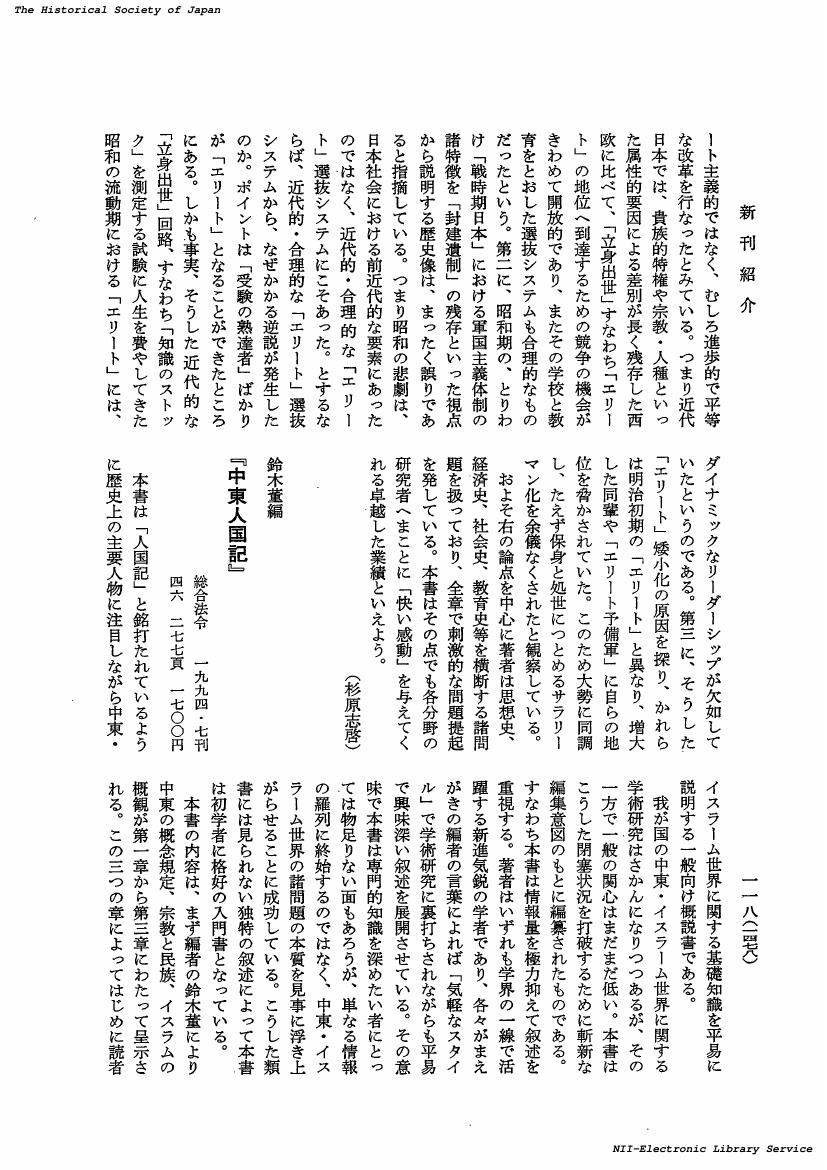- 著者
- 三沢 伸生 ミサワ ノブオ Nobuo MISAWA
- 出版者
- 東洋大学社会学部
- 雑誌
- 東洋大学社会学部紀要 (ISSN:04959892)
- 巻号頁・発行日
- vol.39, no.2, pp.55-78, 2002-02
9 0 0 0 最初の日本人ムスリム : 野田正太郎(1868-1904年)
- 著者
- 三沢 伸生 Akcadag Goknur
- 出版者
- 日本中東学会
- 雑誌
- 日本中東学会年報 (ISSN:09137858)
- 巻号頁・発行日
- no.23, pp.85-109, 2007-07-31
日本とイスラーム世界との関係史への関心が高まるにつれて、最初の日本人ムスリムが誰であるのかという問題にも注目が集まるようになってきている。幕末の開国以来、イスラーム世界に渡航する日本人、イスラーム世界から日本に来訪する人間が現れだした。こうした接触・交流から日本人でムスリムに改定した者が出てきたものと考える。しかしながら日本人のムスリム改宗に関する史料は乏しく、特定・検証作業は極めて困難である。現在、最初の日本人ムスリムとして言及されることが多いのは山田寅次郎である。しかしそれは完全なる誤りである。本稿で実証するように野田正太郎こそが、現在のところ諸史料によって確認することができる最初の日本人ムスリムである。管見の及ぶ限り、山田が最初の日本人ムスリムであるかもしれないと言及したのは、中田吉信氏である。その際に中田氏は1893年8月4日付け『毎日新聞』に掲載された「回々教日本に入らんとす」と題されたある西洋新聞の翻訳記事を主たる根拠とした。この記事には約2年間に及ぶイスタンブルでのコーラン研究を終えた、アブデュルハリルという名の日本人が日本へ帰国したので、今後に日本にイスラーム教が広まるかどうかが注目されると記されている。中田氏はこの記事から、従来最初の日本人ムスリムと言われていた山岡光太郎氏より前に、イスタンブルでムスリムになった日本人がおり、その頃にイスタンブル居住の日本人は山田寅次郎しかいないので、アブデュルハリルは山田以外にありえないと考えた。この仮説を補強するために、山田に関する評伝である『新月山田寅次郎』をもとに、山田が1892年4月にイスタンブルに入り、約1年4ヶ月で日本に一旦帰国した事実を拾い出した。しかしそれでも中田氏は直接証拠を発見できずに山田がアブデュルハリルであると同定するには至らず、仮説としてその可能性を提示するに留まった。しかしこの仮説の反響は大きかった。とりわけ戦前以来の著名な日本人ムスリムである小村不二男氏が、何ら確証を明示することなしに、この仮説を事実として著書に書き記してから、山田が最初の日本人ムスリムであることが定説のようになってしまった。しかし中田氏の仮説を検証してみると、誤りであることは明白である。第1にその当時イスタンブルに住んでいた日本人は山田だけではない。山田の来訪以前の1891年1月から「時事新報』記者の野田正太郎がイスタンブルに住んでいた。第2に山田の伝記には記載事実に混乱が見られ、日本の複数の新聞記事に依拠すれば、約2年後どころか山田はイスタンブルにわずか数ヶ月滞在して一旦日本に帰国していることがわかる。中田氏が考えるように山田がアブデュルハリルであると同定することは困難である。さらに日本・トルコの双方において様々な史料を渉猟した結果、最初の日本人ムスリムのアブデュルハリム(アブデュルハリルは誤り)は、中田氏の推測する山田ではなく、野田であると特定することができる。野田は自社の募集した「エルトゥールル号事件」のための巨額な義損金為替をオスマン朝に手渡しするために、69名の生存者とともに日本軍艦の比叡に便乗して1891年1月にイスタンブルに入った。そしてオスマン朝側が士官学校において日本語を教授しながらトルコ語を習得する日本人の逗留を望んだことから、野田はこの地に留まることとなった。野田は士官(当初2人、最終的には6人)に日本語を教えながら、トルコ語を習い、同時にオスマン史・イスラーム史・イスラーム教などを学習した。やがて如何なる理由からか不明であるが、1891年5月に野田は入信してムスリムとなり、アブデュルハリムの名を授けられた。この事実はイスタンブルの総理府オスマン文書館に保管される文書によって裏づけされる。またこの改宗は新聞・雑誌に掲載され、内外に広く知られることとなった。野田は日本語教育とトルコ語取得に励み、やがてコーランを学習するためにアラビア語を取得する必要性すら感じている。1892年4月に日本人同胞たる山田寅次郎がイスタンブルにやってきた。野田は公私にわたり山田を支援して、貿易業創始という彼の夢を手助けした。さらには自身の日本語教育において彼を短期的に助手として採用したものと考えられる。しかしながら如何なる理由からか後世の短い山田の自叙伝・友人の筆になる山田の評伝にも野田に関する言及が見られない。またこの自叙伝・評伝の記載事実にも混乱が見られ、充分に検証されなくてはならない。こうしたことが絡み合って山田と野田とが取り違えられることとなり、野田が忘却される一方で、山田に注目が集まる結果となったのである。1892年12月に野田は約2年間のイスタンブル滞在を打ち切って、欧米を見聞しながら1893年に日本に帰国した。帰国後は『時事新報』に復帰し、トルコに関係する随筆をいくつか書いたものの、いつしか退社してしまい、その名声も忘れられるようになった。さらに帰国後の彼の生活はムスリムとして賞賛されるものではなかった。新聞によれば彼は奢侈生活に浸り、その生活を続けるために2度の刑事事件にかかわった。晩年の詳細は不明であるが、野田は1904年4月27日に若くして没してしまった。
7 0 0 0 OA 20世紀前半のイスタンブルにおける日本軍部の活動
- 著者
- 三沢 伸生
- 出版者
- 東洋大学社会学部
- 雑誌
- 東洋大学社会学部紀要 (ISSN:04959892)
- 巻号頁・発行日
- vol.53, no.1, pp.21-34, 2015-11
- 著者
- 三沢 伸生 大澤 広嗣
- 出版者
- 日本中東学会
- 雑誌
- 日本中東学会年報 (ISSN:09137858)
- 巻号頁・発行日
- no.28, pp.107-126, 2013-01-05
近年になって、「回教政策」をはじめとして、長らく学界で取り上げることがなかった戦前・戦中期における日本とイスラーム世界との関係についての研究が進んできている。第1に「回教政策」やイスラーム研究の中心人物にかかわる研究、第2に第1と同じく関係団体や研究機関にかかわる研究、第3に日本社会における反響、第4に在日タタール人など在日イスラーム教徒や日本とイスラーム世界との関係にかかわる研究である。このなかで第3の日本社会における反響の研究が遅れている。社会科学一般で用いられているようにメディア研究を進めていくことが必要である。代表的日刊新聞に比べて仏教系日刊新聞『中外日報』にはイスラーム関係の記事が多く所収される。現在、1937年から1945年の同紙に所収されるイスラーム関係記事のデータベース化を進めており、本稿ではその一部を紹介しながら、当時の日本社会におけるイスラーム認識の振幅の一例を示す。
- 著者
- デュンダル メルトハン 三沢 伸生 / ミサワ ノブオ Merthan.A DUNDAR Nobuo MISAWA
- 出版者
- 東洋大学社会学部
- 雑誌
- 東洋大学社会学部紀要 = The Bulletin of Faculty of Sociology,Toyo University (ISSN:04959892)
- 巻号頁・発行日
- vol.46, no.2, pp.181-220, 2009-03
- 著者
- Dundar Merthan A. 三沢 伸生 / ミサワ ノブオ Merthan.A DUNDAR Nobuo MISAWA
- 出版者
- 東洋大学社会学部
- 雑誌
- 東洋大学社会学部紀要 (ISSN:04959892)
- 巻号頁・発行日
- vol.46, no.2, pp.181-220[含 英語文要旨], 2009-03
- 著者
- 三沢 伸生
- 出版者
- アジア文化研究所
- 雑誌
- アジア文化研究所研究年報 = Annual Journal of the Asian Cultures Research Institute (ISSN:18801714)
- 巻号頁・発行日
- vol.56, pp.111(142)-131(122), 2022-01
2 0 0 0 OA アブデュルレシト・イブラヒム関係の新出史料
- 著者
- 三沢 伸生
- 出版者
- 東洋大学アジア文化研究所
- 雑誌
- アジア文化研究所研究年報 = Annual journal of the Asian Cultures Research Institute (ISSN:18801714)
- 巻号頁・発行日
- vol.52, pp.283(84)-290(77), 2017
- 著者
- 三沢 伸生
- 出版者
- 山川出版社
- 雑誌
- 歴史と地理 (ISSN:13435957)
- 巻号頁・発行日
- no.732, pp.図巻頭1p,3-21, 2020-05
1 0 0 0 OA 鈴木董編 『中東人国記』, 総合法令, 一九九四・七刊, 四六, 二七七頁, 一七〇〇円
- 著者
- 三沢 伸生
- 出版者
- 公益財団法人 史学会
- 雑誌
- 史学雑誌 (ISSN:00182478)
- 巻号頁・発行日
- vol.104, no.8, pp.1478-1479, 1995-08-20 (Released:2017-11-30)
本研究ではこれまで看過されてきた戦時期日本の戦略研究としての回教・回教徒研究を積極的に再評価し、戦後展開した基礎的な地域研究としての中東イスラーム地域研究との断続性よりもそれへの継続性に力点を置いて検討することを目的とした。本研究による研究成果としては以下の四つの領域に分類することができる。第一に、アフガニスタン関係資料として、尾崎三雄家所蔵資料の整理・公刊である。第二として、戦時期日本の回教・回教徒研究に関しては、早稲田大学中央図書館に所蔵の大日本回教協会の映像資料「大日本回教協会関係写真資料(Photography of the Greater Japan Muslim League)Ver.1」のCD-ROM化、また、2006年1月にトルコ共和国アンカラにおいて行なったシンポジウム「戦時期日本のイスラーム政策」の成果の一端を『日本中東学会年報(The Annal of the Japan Association of Middle East Studies)』第23号の特集「第二次世界大戦前の日本と中東(Japan and the Middle East before World War II)」として刊行した。第三として、大日本帝国領に亡命していたタタール系ムスリムによって刊行されていたタタール語等の雑誌・新聞類の整理に関しては、第二次世界大戦中に旧満州国ハルビンで刊行されていたタタール語紙『ミッリー・バイラク』に掲載された写真を一枚のDVDにまとめた『Photography Collection of Milli Bayrak(Mukden,1935-1945)Ver.1』としてDVDを刊行した。第四として、戦前日本の回教・回教徒研究を推進・組織化した東亜経済調査局理事長であった大川周明が第一次世界大戦後に多くの論考を投稿していた道会雑誌『道』に掲載された大川周明の論考をデータ化してまとめた。
- 著者
- 三沢 伸生
- 出版者
- 東洋大学社会学部
- 雑誌
- 東洋大学社会学部紀要 = The Bulletin of Faculty of Sociology,Toyo University (ISSN:04959892)
- 巻号頁・発行日
- vol.41, no.1, pp.57-91, 2003-11
- 著者
- 三沢 伸生 ミサワ ノブオ Nobuo MISAWA
- 出版者
- 東洋大学社会学部
- 雑誌
- 東洋大学社会学部紀要 = The Bulletin of Faculty of Sociology,Toyo University (ISSN:04959892)
- 巻号頁・発行日
- vol.43, no.2, pp.149-171, 2006-02
1 0 0 0 IR トルコの書籍・書店事情(2009年度)
- 著者
- 三沢 伸生
- 出版者
- 京都大学イスラーム地域研究センター
- 雑誌
- イスラーム世界研究 (ISSN:18818323)
- 巻号頁・発行日
- vol.3, no.2, pp.509-535, 2010-03
1 0 0 0 第1回「トルコ経済史会議」報告
- 著者
- 三沢 伸生
- 出版者
- 一般社団法人 日本オリエント学会
- 雑誌
- オリエント (ISSN:00305219)
- 巻号頁・発行日
- vol.51, no.1, pp.198-200, 2008
- 被引用文献数
- 1
1 0 0 0 OA 16世紀のオスマン朝における土地問題
- 著者
- 三沢 伸生
- 出版者
- 一般社団法人 日本オリエント学会
- 雑誌
- オリエント (ISSN:00305219)
- 巻号頁・発行日
- vol.37, no.2, pp.127-141, 1994 (Released:2010-03-12)
There are two main themes about land problems of the Ottoman Empire. From the 19th century to 1940's timar system was most popular subject of study in the frame of Islamic feudalism. But now many scholars are interested in iltizam system and çiftlik.For all that, there are still unsolved problems about timar system in the scope of the political formation of the Ottoman Empire. This system was not fixed but flexible with regional and periodical variations owing to the political needs.In the 16th century, the Ottoman Empire grew up an Islamic Empire with its vast territory. In the newly conquered lands, a special land system was putted in force. For example, the mâlikâne-dîvânî system, which is a special timar system, was carried out in Eastern Anatolia. By the analysis of two cadastres about Malatya region, BA 387 (1519/20) and TK 142 (1560), the number of villages where the mâlikâne-dîvânî system in charge (table 1) and the proportion of mâlikâne revenue to the total tax revenue (table 2) suggest that mâlikâne-dîvânî system was step by step changed to the normal timar system during 40 years of the reign of Süleyman I.
1 0 0 0 世界史における民族浄化の総合的研究
本研究では、民族浄化とは民族が国家主権の基礎となるという国民国家理念に起因する近代的現象であるとの仮説の有効性を検討した。三年間の研究期間の間に、ヨーロッパ、ユーラシア、中東、アフリカ、東アジアの幾つもの事例を比較研究し、仮説の有効性は大部分証明された。住民の強制排除、大量追放は、近代初期のヨーロッパに始まり、一九世紀から二〇世紀には東欧・バルカン、中東、旧ソ連、アジア、アフリカへと広がっていったことが確認されたからである。研究の結果、更に重要な発見もなされた。それは民族浄化の発生メカニズムの具体的な解明である。この発見は、ボスニア内戦を中心に、民族浄化を生み出した政治状況、社会的条件、イデオロギー、暴力の展開過程がつぶさに解明された結果であった。ボスニア内戦はユーゴスラヴィ社会主義連邦共和国の解体に起因し、これは一九八○年代のデタントと世界的な金融危機に始まり、一九八九年の東欧革命の余波をうけていた。余波は共和国毎の複数政党選挙という形をとり、選挙後、連邦政府の統合機能が失われ、憲法秩序が崩壊した。これに続いて、独立を目指す共和国が非合法な武装を開始し暴力の独占が崩壊した。こうして、住民の間に生命と財産の不安と恐怖を広がり、従来のアイデンティティが崩壊し、ジェノサイドの「記憶」に基づく危機意識が芽生えた。そして、民族主義者はこれを利用して権力を濫用し、民族浄化を展開したのである。その際、特に民兵の役割が重要であった。民兵は主に犯罪者から組織されていたが、民族解放運動の伝統を利用して自己正当化を図り、受け入れ可能な存在となった。結論として、民族浄化の防止には秩序崩壊時の暴力の統制、特に民兵の排除が中心的課題であることが明らかとなった。
1 0 0 0 IR 20世紀前半のイスタンブルにおける日本軍部の活動
- 著者
- 三沢 伸生
- 出版者
- 東洋大学社会学部
- 雑誌
- 東洋大学社会学部紀要 (ISSN:04959892)
- 巻号頁・発行日
- vol.53, no.1, pp.21-34, 2015-11
1 0 0 0 IR 20世紀前半のイスタンブルにおける日本軍部の活動
- 著者
- 三沢 伸生
- 出版者
- 東洋大学社会学部
- 雑誌
- 東洋大学社会学部紀要 (ISSN:04959892)
- 巻号頁・発行日
- vol.53, no.1, pp.21-34, 2015-11
- 著者
- 三沢 伸生 ミサワ ノブオ Nobuo MISAWA
- 出版者
- 東洋大学社会学部
- 雑誌
- 東洋大学社会学部紀要 = The Bulletin of Faculty of Sociology,Toyo University (ISSN:04959892)
- 巻号頁・発行日
- vol.39, no.2, pp.55-78, 2002-02
